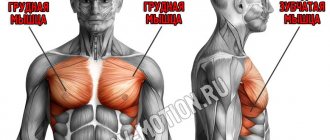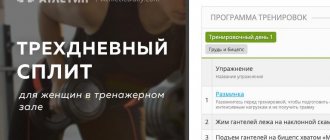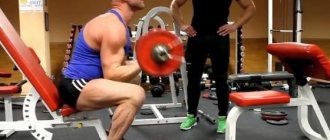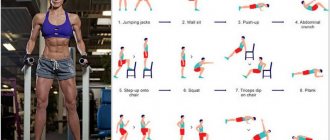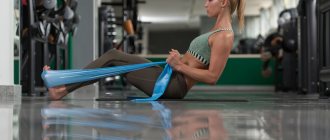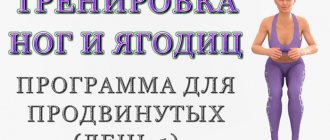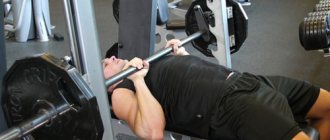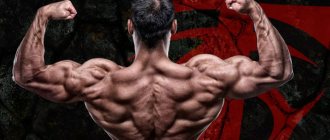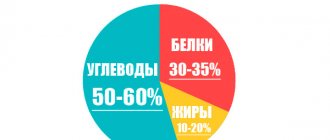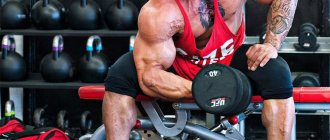Training programsHands on
Show off your muscles! With a program based on the latest research, you can grow your arms to incredible sizes.
Author:
Jim Stoppani, Ph.D.
At Gibson's Gym in Manchester, Connecticut, where I once trained, the T-shirts had the slogan: “It doesn't matter what car you drive. What matters is the size of the hands looking out of the car window.”
Large hands look masculine, and besides, the hands are the most visible part of the body. Therefore, it is not surprising that every guy, and even many women, want to have big hands.
No matter your starting shape, this 6-week program will help add more volume to your arms. Some of you can expect to gain 3cm or more by the end of the program.
This 6 week program is a progression where one of the variables is training frequency (how many times a week you train your arms). You start with one workout in the first week, the second week you do two workouts, the third, fourth and fifth weeks - three workouts each. Then, in the final sixth week, you return to one workout.
Trust me, this method works.
In the first week, your biceps and triceps are destroyed. You will remove all the mechanisms that inhibit growth by repeating a series of exercises that actually break down the muscle tissue in your arms.
After such a load, you need a whole week to recover. The next week the weight is reduced and the number of approaches increases. This week's workouts are not designed for high volume builds yet. You are still recovering from the previous week.
Big hands look masculine, and besides, the hands are the most visible part of the body
These workouts will help you recover better from the previous week and prepare for the next three intense weeks.
In weeks three, four and five you will train your arms three times. If you think that three times a week is too much and may be overtraining, you are right. But retraining does not happen immediately; it takes several weeks. Training that can lead to overtraining is called overexertion training.
Research shows that if your diet contains adequate amounts of calories, protein and carbohydrates, as well as the necessary supplements, you can benefit from overexertion to build stronger muscles faster.
Several studies from the University of Connecticut have confirmed that if muscles are overstrained for two weeks in a row, they grow much faster, and the training person can easily withstand such a load. The main thing is to stop overexertion before it develops into overtraining.
Therefore, according to the program, you will train your arms three times a week - from the third to the fifth week, and then move on to one workout per week. I also suggest that after the sixth week, you give your arms some rest and only train once a week before starting a serious program again.
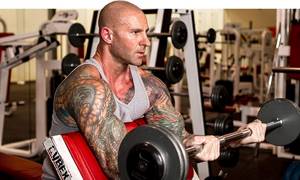
These workouts will help you recover better from the previous week and prepare for the next three intense weeks
Three intense muscle overload workouts are designed to shock your muscles, causing them to grow faster, and they also provide the build-up effect needed to build muscle.
During training, genes in muscle tissue are activated that are responsible for many processes, such as muscle growth and increased strength.
For example, with constant training, certain genes are activated, as a result of which muscle tissue is built faster, i.e. muscle size and strength increases. These genes are usually activated for several hours, sometimes for several days.
If training is regular and lasts the required amount of time, you can achieve even greater activation of genes and, accordingly, even greater growth of muscle mass. This is the so-called load accumulation effect.
Let us explain: during training, a certain gene responsible for muscle growth is activated 100%. After training, his activity gradually decreases over several days such that on the first day after training his activity is still about 75%, on the second day to 50%, and on the third day only 25%. As a result, on the fourth day after training, his activity returns to the initial level.
If you exercise on the fourth day after your previous workout or later, the gene is activated again at 100% of its original activity.
But if you train on the second day after your previous workout, when the gene activity is still 50%, you can increase this activity to 150%. This will lead to greater muscle growth and strength gains compared to training more infrequently.
This is one of the mechanisms that when training every 48 hours provides faster muscle growth compared to training once a week.
Of course, in this program the frequency of training is not the most important thing. They can help you gain extra muscle size, but to get really big muscles you need to remove all the inhibitions. Therefore, it is intensive techniques such as drop sets, forced reps, rest-pause, negative reps and supersets that are necessary in order to make muscles grow.
Such exercises not only put muscles into a stressful state, but also increase hormone levels. A Finnish study found that forced repetitions increased growth hormone levels 3 times more than simply stopping the exercise after muscle failure.
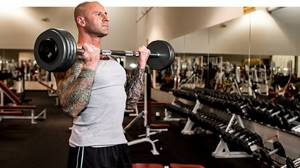
Drop sets, forced reps, negative reps, rest-pause and supersets are necessary to make muscles grow.
This extra growth hormone will come in handy for muscle recovery and growth, and your arm girth will quickly increase. Another study published in the journal Science and Medicine for Sports and Exercise suggests that negative repetition produces high levels of growth hormone.
Another important element of the program is to constantly vary the weight lifted and the number of repetitions. This is called periodization. Research confirms that re-weighting (cycling changes in weight and number of repetitions) produces greater gains in muscle mass and strength.
One of the most effective periodization techniques is wave periodization, which involves constantly changing the weight and number of repetitions each workout. Research by Brazilian scientists from the University of Connecticut has confirmed the effectiveness of such training for increasing muscle volume.
During the third, fourth and fifth weeks you will be exercising your arms quite a bit, and due to this you may be concerned that the muscle soreness is not going away. But no need to worry!
A Japanese study found that if you exercise your muscles two days after an intense workout while they are still sore, it will not interfere with recovery. On the contrary, it will increase the growth of muscle tissue.
Another study suggests that if you train the same muscle group two days in a row, levels of the catabolic hormone cortisol decrease. Because the hormones cortisol and testosterone counteract each other, by reducing cortisol during and after exercise, anabolism increases and your testosterone will be more effective at promoting muscle growth.
Training splits
In order to properly load your arms over the course of 6 weeks, you need to vary the set of exercises. Each week you will complete a new four-day set of exercises.
However, depending on the week and the number of workouts, each of the four days you will train a specific muscle group.
Use the following sets of exercises for each week of the 6 Week Tough Arms program.
Week 1
Monday: Triceps/Biceps Tuesday: Legs : Rest : Back/ : Chest/Shoulders Saturday: Rest Sunday: Rest
Week 2
Monday: Triceps/Biceps Tuesday: Back/Legs Wednesday: Rest Thursday: Triceps/Biceps Friday: Chest/Shoulders/Abs Saturday: Rest Sunday: Rest
Weeks 3-5
Monday: Triceps/Biceps Tuesday: Chest/Shoulders/Abs Wednesday: Back/Triceps/Biceps Thursday: Rest Friday: Triceps/Biceps Saturday: Back/Legs Sunday: Rest
Week 6
Monday: Chest/Abs Tuesday: Back/Calves Wednesday: Rest Thursday: Shoulders/Legs Friday: Triceps/Biceps Saturday: Rest Sunday: Rest
How to pump up your arms? The practical side of the issue.
Pouring water, i.e.

For males, women's hands are not of particular importance; for us, the center of the universe is much more important - the buttocks, and, in general, the proportionality of the figure. However, for the young ladies themselves, the hands are an important “accessory”, and they (you, my dear) want to see them fit and slender, and not with hanging skin and dangling jelly under them with every movement.
Conclusion - everyone wants to see their hands in shape, well, if so, then we will find out how to achieve this.
Note:
For better assimilation of the material, all further narration will be divided into subchapters.
Hand exercises. The most complete list.
I would like to start my story by giving a complete list of all possible arm exercises, both for biceps and triceps. This will help you better navigate when drawing up a training program and will allow you to diversify your manual exercises in the gym.
So, the list of exercises is as follows.
Conditionally basic exercises for triceps:
- press down while standing at the bottom block;
- French press sitting behind the head/lying to the head;
- close grip bench press;
- dips;
- arm extension with a dumbbell while standing on an incline.
Conditionally basic exercises for biceps/forearms:
- standing biceps curl;
- alternate lifting of dumbbells while sitting on a bench;
- arm extension on the Scott bench;
- concentrated dumbbell bicep curl;
- standing reverse barbell raises;
- lifting/lowering the barbell with your hands on your knees.
In the picture version, the assembled atlas of manual exercises looks like this.

Top best arm exercises: research results
A person is a creature who needs all the best, be it an apartment, a car, a job or a partner. A similar trait extends to sports, in particular, the exercises that he uses in his training program. Well, we don’t want to do ordinary exercises, we want the best ones, which are designed to give the same result. The good news is that scientists and various research institutes have taken this wish into account and have identified the very best exercises for the arms that will give the greatest pumping effect. Now we will find out what kind of exercises these are.
The American Council on Exercise , together with scientists from the University of Wisconsin-LaCrosse, in 2014 to identify the best exercises for biceps and triceps. The 8 most popular biceps exercises were taken as subjects
- cable biceps curl while standing at a block;
- biceps curl;
- concentrated dumbbell curls for biceps;
- pull-ups (neutral grip);
- lifting the barbell EZ-bar (wide/narrow grip);
- lifting dumbbells while sitting on a bench at an upward angle;
- arm extension with a dumbbell on a music stand/Scott bench.
...and measurements of the electrical activity of the muscles (in particular the biceps muscle) were made using the electromyography method. 16 volunteers ( 8 men and 8 women) aged 18 to 24 years who had experience with iron training were selected as experimental subjects
The result of this study was the following calculations.
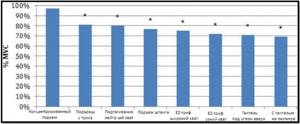
As it turned out, concentrated dumbbell curls showed the most significant activation of the biceps muscles and came out on top compared to other exercises.
In addition to the biceps, the anterior delta and brachyradialis take on the load. Studies have shown that angled dumbbell curls, concentration raises, and pull-ups showed significantly less muscle activation in the anterior deltoid than barbell curls. Lifting dumbbells while sitting on a bench at an upward angle and extending the arms with a dumbbell on a music stand caused significantly less activation in the brachyradialis compared to lifting an EZ barbell with a close grip.
Thus, the study clearly states that the concentrated biceps curl is the best at activating the biceps brachii fibers, and the activation of the anterior deltoid muscle is the lowest compared to the 7 experimental exercises. The latter may be due to the fact that during a concentrated lift, the humerus is pressed tightly against the leg and does not allow the top of the arm to swing, completely isolating the biceps.
Another similar study, only 15 women aged 20 to 24 years were taken as subjects. The goal was to identify the best triceps exercises among the 7 most popular. The experiment showed that the greatest activity of the triceps was achieved when performing push-ups from the floor with the arms in a triangle position. The data was tabulated, with “triangular” push-ups taken 100%

The research clearly shows that the best exercises for the triceps are close-grip push-ups in a triangle position, dumbbell back extensions, and dips/reverse push-ups. This situation is most likely due to the fact that push-ups from the floor/bars/bench use your own body weight, and cheating is impossible in such movements, which cannot be said about other exercises.
Actually, this was a scientific point of view and a research look at the best arm exercises. Now that we have a list of the very best in our hands, it’s time to get down to the training process itself (a tautological sentence, isn’t it? :)), or rather...
Top 3 arm training programs
In the note about shoulders, we considered 3 programs of different directions, or rather, for different categories of workers, and we will do the same this time. So, meet the highlights of the article!
Hand training program No. 1. “Monstrium of the masses.”
It is designed primarily for those athletes who want to gain muscle mass, but classical training programs have no longer worked for him/her.
Technical specifications:
- training 2 times a week – Monday/Friday;
- exercises are performed in a superset - one after another without rest;
- rest for exercises is up to 90 seconds.
In tabular form, the program looks like this:

In the picture it’s like that.
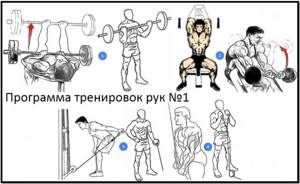
Hand training program No. 2. “Sexy pen.”
PT is designed specifically for fitness ladies who actively visit the gym and want to see their arms more expressive – sexy and sculpted.
Technical specifications:
- training once a week;
- the weight is selected for a given number of repetitions, taking into account that the last 1-2 are done to failure;
- rest for exercises is 45-60 seconds.
In tabular form, the program looks like this:
In the picture it’s like that.

Hand training program No. 3. “Home tightening.”
The main contingent are housewife girls, for example, those who until recently were in an interesting position, and now they are faced with the task of putting their hands in order - removing excess, getting rid of looseness (jelly under the triceps) and toning the muscles.
Technical specifications:
- training 2 times a week;
- the weight is selected for a given number of repetitions, taking into account that the last 1-2 are done to failure;
- PT implies, if possible, increasing the number of repetitions by 1-2 every week;
- rest for exercises is 60 seconds.
In tabular form, the program looks like this:
In the picture it’s like that.
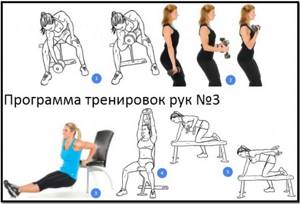
Well, that’s all, actually, now you have training programs for your hands on your hands :), and this means that you can start working on your rakes). Our mission for this note has been largely completed, so let’s sum it up and say goodbye.
Week 1
Monday
Rest between sets: 2-3 minutes
Close grip bench press negative reps
3
sets of
5
reps
Close-grip bench press rest-pause
3
sets of
8
reps
Seated French press drop sets
3
sets of
8
reps
Triceps extension on the upper block drop sets
3
sets of
8
reps
Barbell curls negative reps
3
sets of
5
reps
Barbell curls for biceps rest-pause
3
sets of
8
reps
Alternating dumbbell curls on an incline bench drop sets
3
sets of
8
reps
EZ-bar biceps curl on Scott bench drop sets
3
sets of
8
reps
Negative repetitions.
For negative reps, use about 20% more weight than your one-rep maximum, and have someone help you with the positive portion of the reps. You should slowly lower the weight in the negative phase for 3-5 seconds.
Rest-pause.
Take two rest breaks on the last set. To do this, after muscle failure, rest for 15 seconds and continue the set, then rest again for 15 seconds after the next muscle failure, and continue again.
Drop sets.
Perform two drop sets on the last set, reducing the weight by 20-30% at once and continuing the set.
Features of arm training in bodybuilding
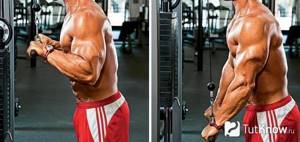
Very often you can find recommendations about dedicating an entire training day to developing your arms. This is easy to explain. Although the arms are used in various exercises, very often their muscles are already very tired, which will not allow you to work them effectively.
We will talk about how to train your hands a little lower, but now we need to touch on the topic of recovery. This is due to the fact that many athletes do not see progress when training arm muscles for the reason that they simply do not have time to recover.
We have already said that the arms are involved in performing various exercises, and it is necessary to find the optimal scheme for training them. Here you can choose one of the training methods:
- Set aside separate days to work on large muscles - back, chest and arms. It is best to use if you have at least a year and a half of training experience.
- Train pulling and pushing muscles on the same day. On back day, also train your biceps and triceps.
- Using the principle of antagonistic muscles. Triceps are trained with the back, and biceps are trained with the chest.
These are just tips and you should experiment and find the optimal scheme.
The best exercises to train your triceps
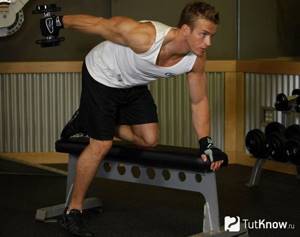
Close grip barbell press
This is a basic exercise for training the triceps. At the same time, you must learn to focus the load on this particular muscle. Take the sports equipment with a medium grip from below. Your feet should be firmly planted on the ground, and the barbell should be at arm's length and positioned at approximately shoulder level. Start lowering the bar until it touches your chest. It is very important that your elbow joints are moved out to the side at approximately a 45-degree angle relative to your body.
Dips
A very effective exercise if you focus on the triceps. To do this, you need to keep your hands close to your body with a minimal forward tilt of the body. Also, your hands should be shoulder-width apart.
French incline press
When performing the exercise, most of the load falls on the triceps, and the minimum on the deltoids and pectoral muscles. Lie down on a bench and grab an EZ bar. In the initial position, the projectile is placed in the arms, bent at the elbow joints at an angle of 90 degrees. Slowly lift the projectile and return to the starting position. You should feel a load in your triceps as you perform the movement. If this does not happen, then your elbow joints were not locked and you did not benefit from the press.
For more information on how to train your arms for mass, see:
